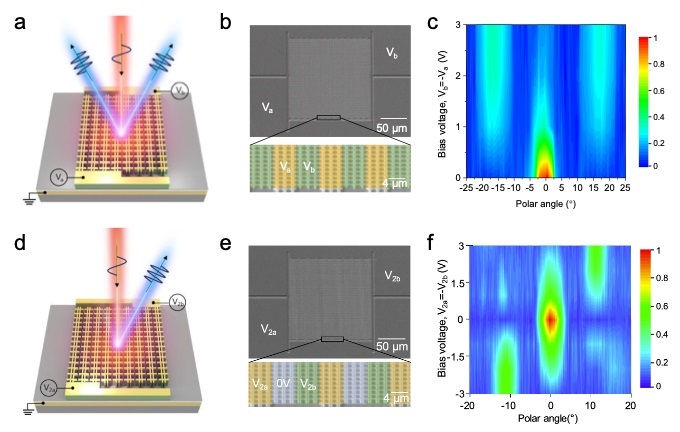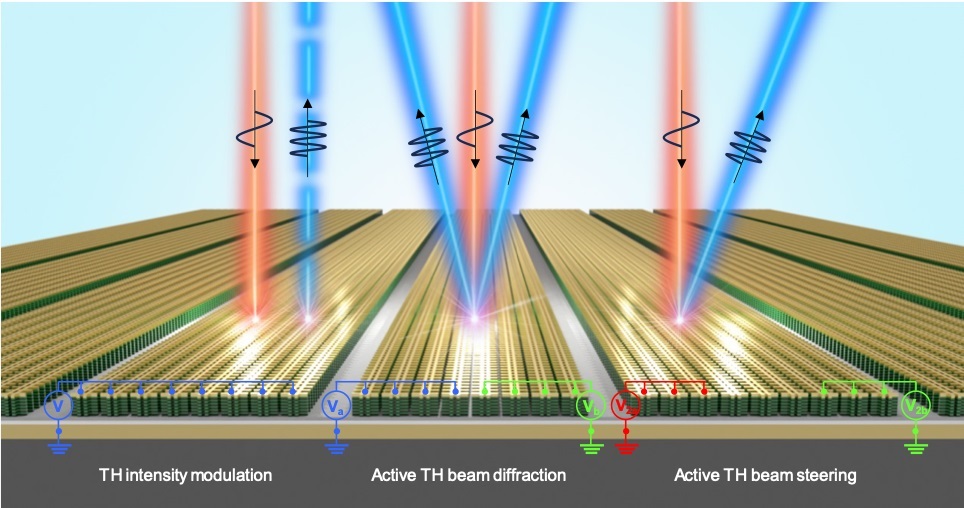Sep 27, 2024
JooHyeon Heo
A groundbreaking study, led by Professor Jongwon Lee in the Department of Electrical Engineering at UNIST has unveiled a transformative nonlinear optical metasurface technology. This new technology, characterized by structures smaller than the wavelength of light, paves the way for significant advancements in next-generation communication technologies, including quantum light sources and medical diagnostic devices.
For the first time, this study showcases experimental implementations of electrically tunable third-harmonic generation (THG) using an intersubband polaritonic metasurface combined with multiple quantum wells (MQWs). Notably, the researchers achieved a remarkable 450% modulation depth of the THG signal and an 86% suppression of zero-order THG diffraction, with local phase tuning exceeding 180 degrees. Additionally, they demonstrated THG beam steering utilizing phase gradients, proposing a new pathway for electrically adjustable flat nonlinear optical elements with versatile functionalities.
Nonlinear optics, which explores the interaction between light and matter, can generate multiple wavelengths from a single light source, significantly enhancing information transmission compared to traditional single-wavelength lasers. A widely recognized example of nonlinear optical technology is the green laser pointer.
The innovative nonlinear optical metasurface created by Professor Lee’s team allows for the development of compact and lightweight optical instruments, with laser devices possibly as thin as paper and utilizing materials even thinner than a human hair. While prior methods struggled with electrical control, this new metasurface can be easily modulated, making it a game changer in the field.

Figure 2. Schematic image showing a metasurface that controls not only the wavelength but also the intensity and phase of light.
Notably, the team has introduced the world’s first technology that allows for voltage control of second-harmonic generation (SHG) and achieved independent modulation of the intensity and phase of THG, enabling the metasurface to control not only the wavelength but also the intensity and phase of light.
“This advancement allows for unprecedented control of light,” said Professor Lee. “By adjusting the intensity and phase of nonlinear THG through electrical means, we open new avenues for applications in light modulation for cryptography, dynamic holography, next-generation quantum sensors, and quantum communication light sources.”
Researcher Seongjin Park highlighted “The properties of our optical metasurface are defined by the semiconductor layer and metal structure.” He further noted, “We have overcome previous limitations by enabling adjustments to light’s phase, amplitude, and frequency.”
Their findings have been published in the Light: Science and Applications on July 17, 2024. The study has been conducted with support from the Mid-Career Researcher Program by the National Research Foundation of Korea (NRF).
Journal Reference
Seongjin Park, Jaeyeon Yu, Gerhard Boehm, et al., “Electrically tunable third-harmonic generation using intersubband polaritonic metasurfaces,” (2024).
Abstract
Nonlinear intersubband polaritonic metasurfaces, which integrate giant nonlinear responses derived from intersubband transitions of multiple quantum wells (MQWs) with plasmonic nanoresonators, not only facilitate efficient frequency conversion at pump intensities on the order of few tens of kW cm-2 but also enable electrical modulation of nonlinear responses at the individual meta-atom level and dynamic beam manipulation. The electrical modulation characteristics of the magnitude and phase of the nonlinear optical response are realized through Stark tuning of the resonant intersubband nonlinearity. In this study, we report, for the first time, experimental implementations of electrical modulation characteristics of mid-infrared third-harmonic generation (THG) using an intersubband polaritonic metasurface based on MQW with electrically tunable third-order nonlinear response. Experimentally, we achieved a 450% modulation depth of the THG signal, 86% suppression of zero-order THG diffraction tuning based on local phase tuning exceeding 180 degrees, and THG beam steering using phase gradients. Our work proposes a new route for electrically tunable flat nonlinear optical elements with versatile functionalities.





